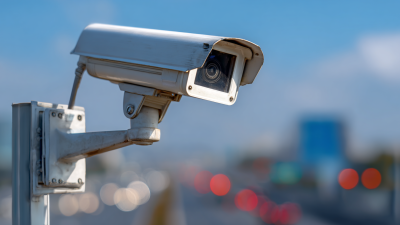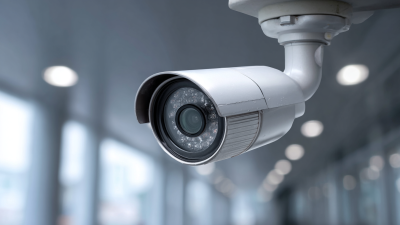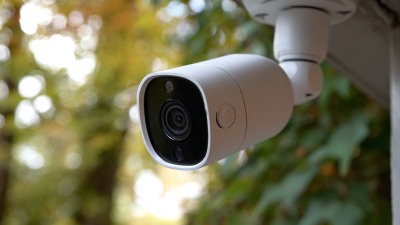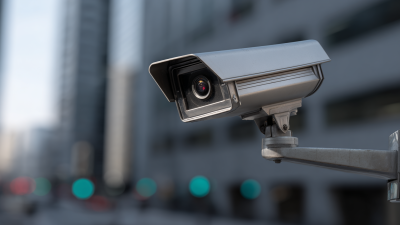
In today's digital age, safeguarding our homes has become more crucial than ever, and the rise of the Wifi Camera has revolutionized home security and monitoring. According to a recent report by MarketsandMarkets, the global smart home security market is projected to reach $74.75 billion by 2025, growing at a compound annual growth rate (CAGR) of 28.4%. Wifi Cameras, in particular, play a pivotal role in this surge, providing homeowners with convenient, real-time surveillance that can be accessed remotely. These cameras not only enhance security through high-definition video and motion detection but also integrate seamlessly with other smart home devices. As technology evolves, the capabilities of Wifi Cameras are expanding, making them an essential tool for those looking to enhance their home security system effectively. This guide will explore how to maximize the benefits of Wifi Cameras for optimal monitoring and protection of your home.

Choosing the right WiFi camera for your home security needs is crucial in today's era of smart technology. With the rise of intelligent home security products, the demand for effective surveillance solutions has significantly increased. According to a report, the global market value for wireless home security cameras is projected to reach $9.8 billion in 2024, with a compound annual growth rate exceeding 13.6% from 2025 to 2034. This growth is largely driven by the increasing adoption of smart home technologies, which incorporate advanced features like artificial intelligence, facial recognition, and object detection.
When selecting a WiFi camera, consider features such as resolution, field of view, and integration with other smart home systems. For instance, cameras that offer 360-degree coverage and high optical zoom capabilities can provide comprehensive monitoring of your property. Additionally, the ability to track pets or loved ones within the home adds value and peace of mind.
As the smart home security market evolves, understanding the unique specifications and potential functionalities of different models will be essential for ensuring a secure and monitored environment for your family.
Setting up your WiFi camera for optimal performance and coverage requires careful consideration of various factors. First, choose the right location for your camera. Ideally, it should be positioned at a height that allows it to capture a wide field of view while being discreet enough to deter potential intruders. Corners of rooms or near entry points are often ideal spots. Ensure that your camera is placed within range of your WiFi signal to maintain a stable connection, as weak signals can lead to poor video quality and increased latency.
Next, consider the angle and adjustments for capturing the most significant areas of your home. Tilt and pan features can enhance your camera's coverage, allowing you to monitor multiple areas without needing additional cameras. Additionally, ensure that your camera is equipped with night vision capabilities for round-the-clock surveillance. Regularly reviewing and adjusting the camera's angle can help you refine the monitoring process and ensure that nothing goes unnoticed. With these steps, your WiFi camera can become an integral part of your home security system, providing peace of mind and safety.
 Integrating a Wi-Fi camera with smart home devices significantly enhances home security and monitoring.
According to a report by Statista, the smart home market is projected to reach approximately $174 billion by 2025. This growth underscores the increasing consumer interest in interconnected devices that enhance property safety. By linking Wi-Fi cameras to smart home systems such as smart locks, motion sensors, and alarm systems, homeowners can create a cohesive security network that provides real-time alerts and remote access to surveillance feeds.
Integrating a Wi-Fi camera with smart home devices significantly enhances home security and monitoring.
According to a report by Statista, the smart home market is projected to reach approximately $174 billion by 2025. This growth underscores the increasing consumer interest in interconnected devices that enhance property safety. By linking Wi-Fi cameras to smart home systems such as smart locks, motion sensors, and alarm systems, homeowners can create a cohesive security network that provides real-time alerts and remote access to surveillance feeds.
Additionally, a survey conducted by Parks Associates found that 30% of U.S. households own at least one smart home device, with security cameras being among the most popular. When integrated with voice assistants like Amazon Alexa or Google Assistant, homeowners can control their cameras using simple voice commands, thus simplifying the monitoring process.
Features like automatic alerts and live streaming through smart screens make it easier for users to keep an eye on their property, whether they are home or away. This seamless integration not only offers convenience but also enhances the overall security landscape, making it crucial for homeowners to leverage available technology effectively.
When using a WiFi camera for home security and monitoring, effectively managing and monitoring footage is crucial. One essential tip is to regularly check the camera settings to ensure that motion detection and recording options are optimally configured. Set the camera to start recording when it detects movement, which helps in conserving storage space and makes it easier to review important footage. Additionally, consider adjusting the sensitivity settings to avoid false alerts caused by moving pets or trees swaying in the wind.
Another vital aspect is to utilize cloud storage solutions. Many WiFi cameras offer cloud storage plans that allow you to save recorded footage securely online. This is advantageous in case of theft or damage to the camera itself, ensuring that you retain the evidence. Regularly review your cloud storage to keep track of what needs to be saved or deleted, and use the camera’s mobile app to receive real-time notifications when motion is detected, allowing you to quickly assess the situation from anywhere.

Utilizing a WiFi camera for home security has become increasingly popular due to its range of features that enhance safety and monitoring. Beyond simply capturing footage, many modern cameras come equipped with additional functionalities such as motion detection, two-way audio, and night vision. Motion detection alerts homeowners instantly when any movement is detected, allowing for prompt action if necessary. Two-way audio facilitates real-time communication, making it possible for users to speak to visitors or intruders through their camera, adding an extra layer of interaction.
Implementing best practices is crucial for maximizing the effectiveness of a WiFi camera. First, ensure that your camera is placed strategically in high-traffic areas of your home, such as entrances and living spaces. Regularly update the camera's firmware to enhance security and performance and to protect against vulnerabilities. Additionally, secure your WiFi network with strong passwords and encryption to prevent unauthorized access to your camera feeds. By integrating these features and practices, homeowners can significantly bolster their security measures, providing peace of mind through continuous monitoring and control.






